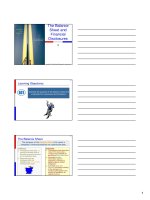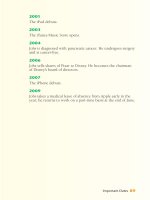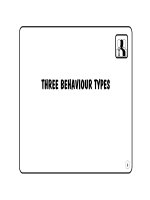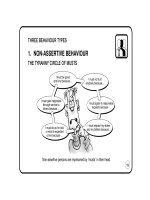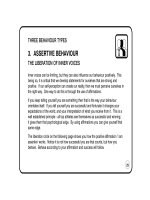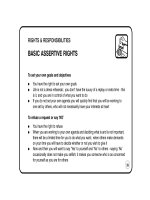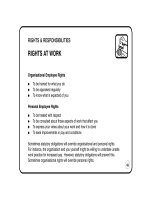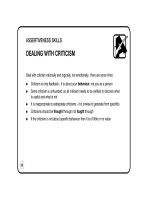THE BALANCE SHEET POCKET BOOK phần 10 pptx
Bạn đang xem bản rút gọn của tài liệu. Xem và tải ngay bản đầy đủ của tài liệu tại đây (143.89 KB, 13 trang )
APPENDIX ONE
JARGON EXPLAINED
Page
Profit and A financial statement measuring profit performance for a 69
Loss Account: stated trading period
Receivables: See Debtors
Reserves: A collective term for undistributed profits which form part 54
of Shareholders’ Funds. The principal reserves are:
Retained Profits, Share Premium Account
and Revaluation Reserve
Retained
Profits: Profits which are reinvested within the business 16
Revaluation On revaluing Fixed Assets any increase or decrease in 55
Reserve: value is matched by an increase or decrease in
the Revaluation Reserve
Revenue
Account: See Profit and Loss Account
98
NB
APPENDIX ONE
JARGON EXPLAINED
Page
Revenue All expenditure which does not result in an increase 36
Expenditure: in the value of Fixed Assets
ROCE: Return on Capital Employed. Measures the effective use of 88
Net Capital Employed to generate Operating Profit
Operating Profit
= x 100
Net Capital Employed
Sales: The invoice value of goods sold (excluding VAT) 74
Share Capital: Long-term funding by Shareholders who buy a share 10
of the business ownership
Share
Premium When shares are issued at a price above nominal 54
Account: value, the premiums are accumulated to form this Reserve
99
NB
APPENDIX ONE
JARGON EXPLAINED
Page
Shareholders’ The total shareholder investment in the business, 60
Funds: ie: Share Capital and Reserves
Stock: The total value of raw materials, work in progress 21
and finished goods
Tax: Part of company profits have to be used to finance the 81
tax bill paid to the Government
Trading
Account: See Profit and Loss Account
Turnover: See Sales
Working Funds used to provide the flow of materials, services and 22
Capital: credit. (Current Assets - Current Liabilities)
Written Down
Value: See Net Book Value
100
NB
APPENDIX TWO
CALCULATING DEPRECIATION
101
NB
APPENDIX TWO
CALCULATING DEPRECIATION
How do accountants decide how much depreciation to charge?
Depreciation is
Assessed on an annual basis by apportioning the
‘depreciable amount’ over the
‘effective useful life’.
102
NB
APPENDIX TWO
CALCULATING DEPRECIATION
● What is the depreciable amount?
That part of the Capital Expenditure which is ‘consumed’ by the business
ie: Cost less residual/scrap value at the end of the asset’s useful life to the business
103
NB
APPENDIX TWO
CALCULATING DEPRECIATION
● What is the effective useful life?
The period over which the business intends to use the Fixed Assets.
40-50 years? 3-5 years?
4-25 years? 2-5 years?
● How many years will it benefit the business?
- how long will the asset last?
- what is the likelihood of a breakthrough in technology?
- and when would this happen?
- what is the market life of the products requiring this facility?
The accountant may need some help deciding this!
104
NB
APPENDIX TWO
CALCULATING DEPRECIATION
STRAIGHT-LINE METHOD
The most simple basis for apportioning the depreciable amount over the effective
useful life is the `straight-line’ method.
Depreciable amount
Useful life
= £ p.a.
Example:
A company purchases a new machine which costs £500,000 to make a product which
has an expected life of 5 years. It is estimated that at the end of the 5 years the
machine will have a resale value of £50,000.
Depreciation charge p.a. = £500,000 - £50,000
5 years
= £90,000 p.a.
105
NB
APPENDIX TWO
CALCULATING DEPRECIATION
OTHER METHODS
There are other methods of calculating depreciation, eg:
● Reducing balance - where the depreciation charge is a fixed % per annum of the
reduced balance (ie: cost less cumulative depreciation)
● Production Unit method - where the depreciation charge depends on the number
of units of output produced
Companies must select the method which is most appropriate to the asset in question
and its application within the business.
The choice of method and the parameters used MATTER.
It affects - Profit
- Product Cost
- Fixed Asset Values
Don’t let the accountant take sole responsibility!
106
NB
About the Authors
Anne Hawkins, BA, CIMA is a Management Accountant with a first class honours
degree in Business Studies. Anne has progressed from this strong knowledge
base to gain senior management accounting experience within consumer and
industrial product industries. As a Training Consultant she develops and presents
finance programmes to Directors and Managers from all sections of industry.
Clive Turner, ACMA, MBCS is Managing Director of Structured Learning
Programmes Ltd, established in 1981 to provide management consultancy and
training services. Clive works with management to develop strategic business
options. He participates in the evaluation process: designs the appropriate
organisation structure and provides management development to support the
implementation process. Clive continues to have extensive experience in
delivering financial modules within Masters Programmes in the UK and overseas.
Contact
For details of support materials available to help trainers and managers run finance
courses in-company, contact the authors at:
Tall Trees, Barkers Lane, Wythall, West Midlands B47 6BS.
© Anne Hawkins and Clive Turner 1995
This edition published in 1995 by Management Pocketbooks Ltd.
14 East Street, Alresford, Hants. SO24 9EE, UK Reprinted 1997, 1999, 2000
Printed in England ISBN 1 870471 326
TRAINERS, HRD MANAGERS
and TEAM LEADERS!
BUILD KEY MANAGEMENT
SKILLS with Games
Exercises, Tests
& Quizzes
that will ABSORB
ENTERTAIN &
ENLIGHTEN
MANAGEMENT
POCKETBOOKS
THE MANAGEMENT POCKETBOOK SERIES
Pocketbooks
Appraisals Pocketbook
Assertiveness Pocketbook
Balance Sheet Pocketbook
Business Planning Pocketbook
Business Presenter’s Pocketbook
Business Writing Pocketbook
Challengers Pocketbook
Coaching Pocketbook
Communicator’s Pocketbook
Creative Manager’s Pocketbook
Cross-cultural Business Pocketbook
Cultural Gaffes Pocketbook
Customer Service Pocketbook
Decision-making Pocketbook
Empowerment Pocketbook
Export Pocketbook
Facilitator’s Pocketbook
Improving Efficiency Pocketbook
Improving Profitability Pocketbook
Influencing Pocketbook
Interviewer’s Pocketbook
Key Account Manager’s Pocketbook
Learner’s Pocketbook
Managing Budgets Pocketbook
Managing Cashflow Pocketbook
Managing Change Pocketbook
Managing Your Appraisal Pocketbook
Manager’s Pocketbook
Manager’s Training Pocketbook
Marketing Pocketbook
Meetings Pocketbook
Mentoring Pocketbook
Motivation Pocketbook
Negotiator’s Pocketbook
Networking Pocketbook
People Manager’s Pocketbook
Performance Management Pocketbook
Personal Success Pocketbook
Project Management Pocketbook
Problem Behaviour Pocketbook
Quality Pocketbook
Sales Excellence Pocketbook
Salesperson’s Pocketbook
Self-managed Development Pocketbook
Stress Pocketbook
Teamworking Pocketbook
Telephone Skills Pocketbook
Telesales Pocketbook
Thinker’s Pocketbook
Time Management Pocketbook
Trainer Standards Pocketbook
Trainer’s Pocketbook
Pocketfiles/Other
Leadership: Sharing The Passion
The Great Presentation Scandal
Hook Your Audience
Trainer’s Blue Pocketfile of
Ready-to-use Exercises
Trainer’s Green Pocketfile of
Ready-to-use Exercises
Trainer’s Red Pocketfile of
Ready-to-use Exercises
Audio Cassettes
Tips for Presenters
Tips for Trainers
Please send me:
The
Balance Sheet
Pocketbook
The Pocketbook
The Pocketbook
The Pocketbook
The Pocketbook
Your details
Name
Position
Company
Address
Telephone
Facsimile
VAT No. (EC companies)
Your Order Ref
ORDER FORM
No.
copies
Order by Post
MANAGEMENT POCKETBOOKS LTD
14 EAST STREET ALRESFORD HAMPSHIRE SO24 9EE UK
Order by Phone, Fax or Internet
Telephone: +44 (0)1962 735573
Facsimile: +44 (0)1962 733637
E-mail:
Web: www.pocketbook.co.uk
Customers in USA should contact:
Stylus Publishing, LLC, 22883 Quicksilver Drive,
Sterling, VA 20166-2012
Telephone: 703 661 1581 or 800 232 0223
Facsimile: 703 661 1501 E-mail:
